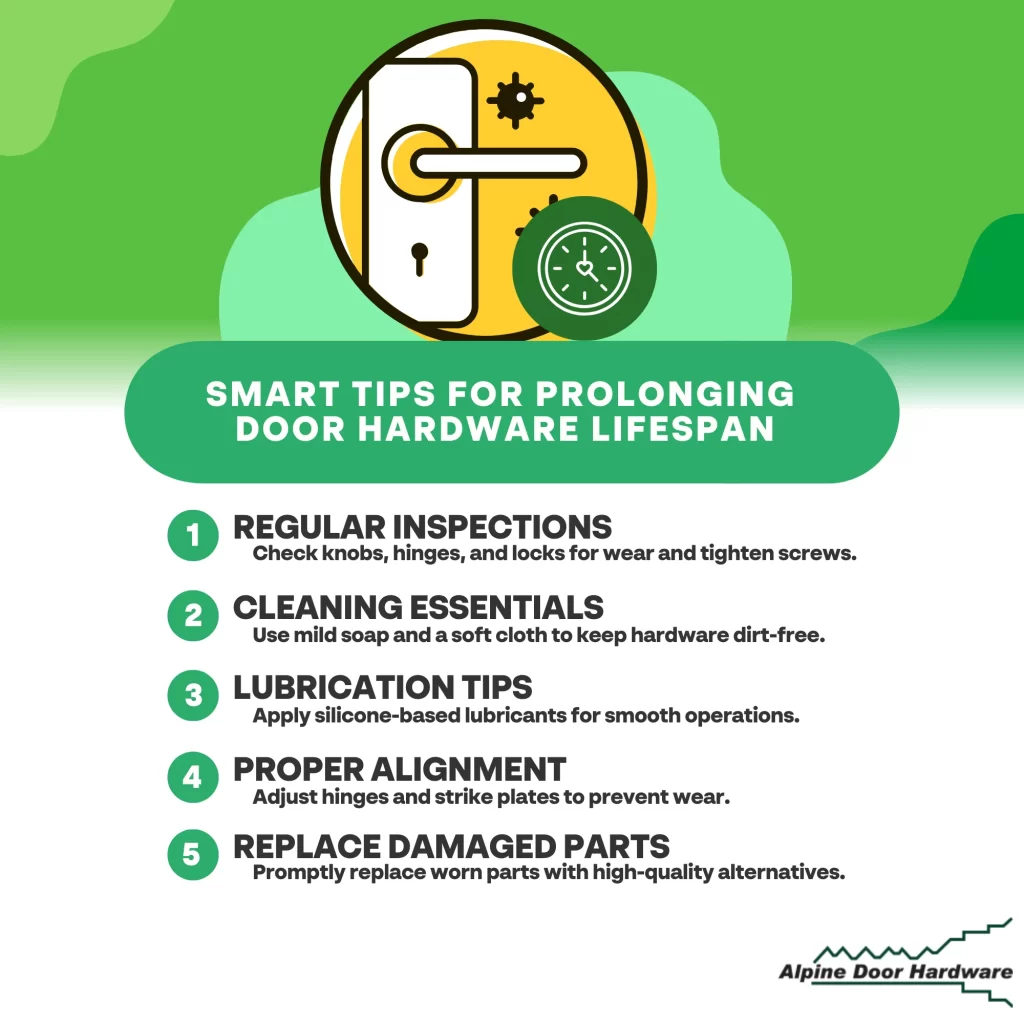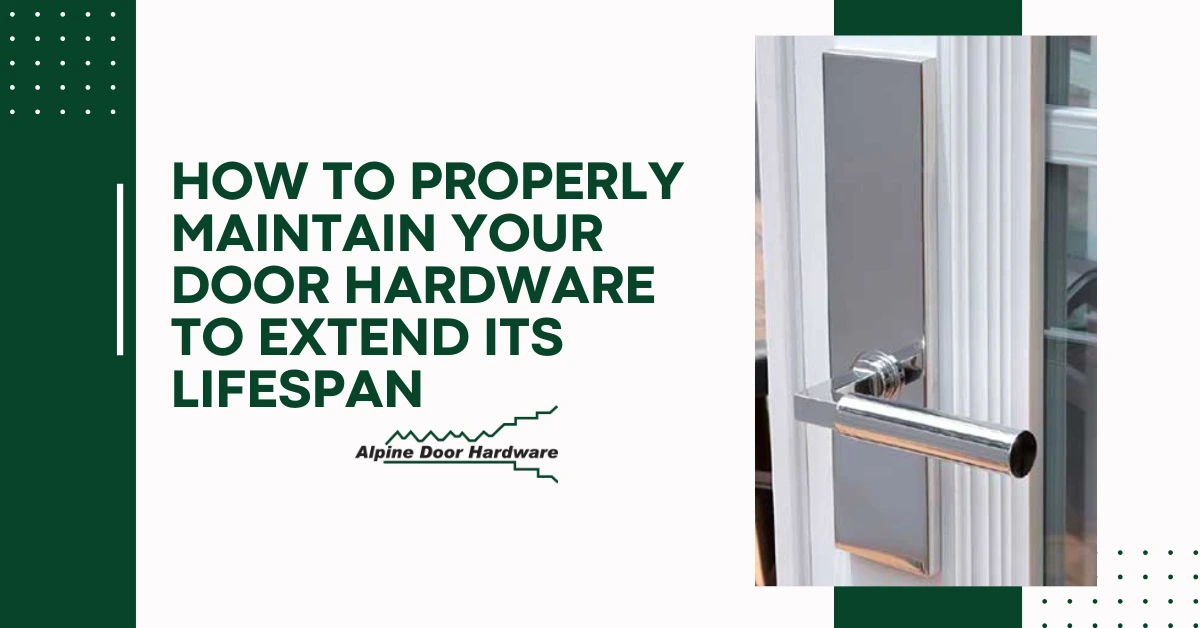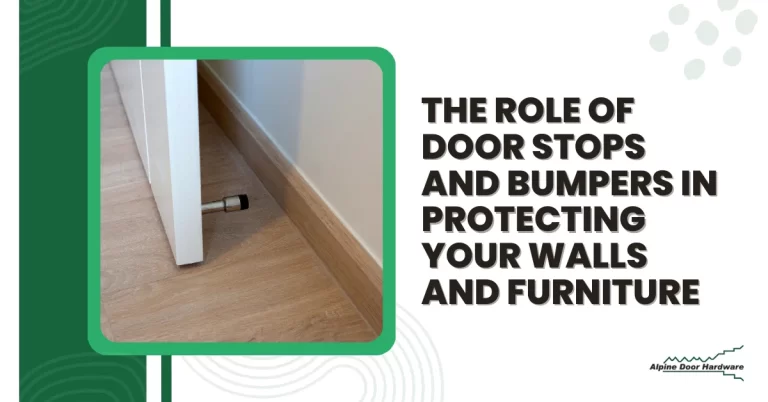Properly maintain your door hardware to extend its lifespan, start with regular inspections. Look for wear on knobs, levers, and deadbolts, tightening any loose screws. Clean the hardware with a soft cloth and mild soap to prevent buildup. Apply a high-quality lubricant to moving parts for smooth operation. Don’t forget to check hinges and strike plates, ensuring everything aligns well. If you notice rust or damage, replace those parts promptly with quality replacements. Keeping a maintenance log will help you track these tasks and enhance your hardware’s longevity. You’re just getting started on a journey to lasting door care.

Key Takeaways
- Conduct regular inspections of door hardware to identify wear and address issues promptly.
- Clean hardware with mild soap and lubricate moving parts for smooth operation.
- Tighten screws, hinges, and strike plates to ensure proper alignment and functionality.
- Replace any worn or damaged parts with high-quality components to maintain security.
- Maintain a log of inspections and repairs to track the performance of your door hardware.
Regular Inspections
Regularly inspecting your door hardware is vital to guaranteeing both security and functionality. Start by checking the condition of your door knobs, levers, and deadbolts. Look for signs of wear, such as loose or wobbly components, which can compromise security. Tightening screws and bolts can often resolve minor issues, so keep a screwdriver handy for quick fixes.
Next, assess the alignment of your doors. If they’re not closing properly or have gaps, it might indicate a need for adjustment. Misalignment can lead to increased wear and tear on your hardware, so addressing this promptly is important.
Consider hiring a door maintenance company for a thorough inspection. They can identify issues you might overlook and provide expert advice tailored to your specific hardware. Regular maintenance not only extends the lifespan of your hardware but also enhances your home’s security.
Finally, document your inspections and any repairs or adjustments made. This record can help track the performance of your door hardware over time and inform future maintenance needs. By staying proactive with your door hardware maintenance, you’ll guarantee a safe and functional entryway for years to come.
Cleaning and Lubrication
To keep your door hardware functioning smoothly, regular cleaning and lubrication are essential. Start by wiping down surfaces to remove dirt and grime, then apply a suitable lubricant to the moving parts to prevent wear and tear. This simple maintenance routine not only enhances performance but also extends the lifespan of your hardware.
Cleaning Door Hardware
Cleaning and maintaining door hardware is essential for guaranteeing both functionality and security. Regular cleaning not only keeps your hardware looking great but also prevents dirt and grime from affecting its performance. Here’s how to clean door hardware effectively:
- Use a soft cloth: Dampen a microfiber cloth with mild soap and water to wipe down the surface of your door hardware gently. Avoid harsh chemicals that could damage the finish.
- Focus on crevices: Use an old toothbrush or a soft brush to clean hard-to-reach areas, like around knobs or levers, where dust and dirt accumulate.
- Rinse and dry: After cleaning, make sure to wipe off any soap residue with a clean, damp cloth and dry thoroughly to prevent water spots.
For ongoing door hardware maintenance support, regularly check your hardware for signs of wear or damage. By knowing how to clean door hardware properly, you can help extend its lifespan and maintain its appearance. Taking these simple steps will guarantee your hardware remains functional and secure for years to come.
Lubricating Moving Parts
When it comes to maintaining door hardware, lubricating moving parts is essential for ensuring smooth operation and prolonging the lifespan of your locks and hinges. Regular door lock maintenance prevents wear and tear, reducing the risk of malfunction. To get started, choose a high-quality lubricant, like silicone spray or graphite powder, which won’t attract dust and dirt.
Begin by inspecting all moving parts, including hinges, latch mechanisms, and deadbolts. Clean these areas with a soft cloth to remove any grime or debris. Next, apply the lubricant directly to the moving components. For hinges, open and close the door a few times to work the lubricant in. With locks, insert the key and turn it several times to distribute the lubricant evenly.
Tightening and Adjusting
Maintaining the functionality of your door hardware involves regularly tightening and adjusting components to guarantee peak performance. Over time, screws can loosen, and hinges may shift, leading to operational issues. By taking a few minutes to inspect and adjust your hardware, you can prevent more extensive door hardware repair down the line.
Here are some key areas to focus on during your maintenance routine:
- Hinges: Check if they’re tight. If not, use a screwdriver to secure them.
- Knobs and Levers: Verify they operate smoothly. Tighten any loose screws for a better grip.
- Strike Plates: Confirm that they’re aligned properly with the latch. Adjust screws if necessary for a snug fit.
Regular door hardware maintenance not only keeps your doors functional but also enhances security. By tightening and adjusting these components, you’re making certain that everything works as intended. This proactive approach can save you from costly repairs later and extend the lifespan of your door hardware. Make this a part of your regular home maintenance routine, and you’ll enjoy smooth operation for years to come.
Replacing Worn or Damaged Parts
Over time, even the most reliable door hardware can experience wear and tear, leading to potential security risks and operational issues. If you notice any parts that are worn or damaged, it’s essential to replace them promptly to maintain the integrity of your door hardware lock functions.
Begin by evaluating the condition of your locks, handles, and hinges. Look for any signs of rust, cracks, or misalignment. If you find any issues, you’ll need to source replacement parts that match your current hardware. Make sure to choose high-quality components that fit the specifications of your existing system.
When replacing parts, always follow the manufacturer’s guidelines for installation, ensuring that you maintain the door’s overall functionality. Pay special attention to the alignment of the lock and latch, as proper installation is vital for effective operation and security.
Regularly check your door hardware during maintenance door inspections, and don’t hesitate to replace parts as needed. By taking these proactive steps, you’ll enhance the lifespan of your door hardware and maintain the security of your property.
Frequently Asked Questions
How Often Should I Replace My Door Hardware?
Is your door hardware still turning smoothly? You should replace it every 5-10 years or sooner if you notice wear. Regular checks help maintain security and functionality, ensuring your home remains safe and accessible.
What Are Signs of Hardware That Needs Replacement?
You’ll notice signs like difficulty turning knobs, rust or corrosion, squeaking sounds, or misalignment. If your hardware shows wear or feels unstable, it’s time to contemplate replacement for improved security and functionality.
Can I Use Oil-Based Lubricants on Door Hardware?
Think of your door hardware as a well-oiled machine. You should avoid oil-based lubricants; they can attract dirt and grime. Instead, use silicone-based or graphite lubricants for smoother operation and longer-lasting performance.
Are There Specific Products for Outdoor Door Hardware Maintenance?
Yes, there are specific products designed for outdoor door hardware maintenance. Look for weather-resistant lubricants, rust inhibitors, and protective sprays. These guarantee your hardware withstands the elements while maintaining functionality and appearance for years to come.
How Can I Prevent Rust on Metal Door Hardware?
Like a shield against the storm, you can prevent rust on metal door hardware by applying a protective coating, keeping surfaces dry, and regularly checking for moisture. Routine cleaning also helps maintain its condition and appearance.
Conclusion
By incorporating these essential door hardware maintenance practices into your routine, you can enhance the performance, durability, and security of your home’s door hardware. Regular door lock maintenance, including cleaning, lubricating, and tightening, ensures smooth operation and prevents wear and tear. If you’re unsure about how to clean door hardware or manage door hardware lock functions, simple steps like using non-abrasive cleaners and applying appropriate lubricants can work wonders. For more complex needs, consider consulting a door maintenance company for professional door hardware repair or support. Understanding door hardware installation and maintenance is vital to preventing issues like squeaky hinges or misaligned locks. Learning door hardware 101 and the 4 types of hardware maintenance—cleaning, adjusting, lubricating, and replacing worn parts—helps you avoid unexpected issues. Whether it’s maintaining door hardware lock functions or ensuring the longevity of your maintenance door, these proactive measures save time and money while keeping your home secure. Proper care not only keeps your door hardware reliable but also enhances its appearance, giving you peace of mind every day. Safety can never be a afterthought!




